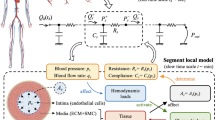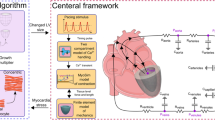Abstract
To strengthen the detailed understanding of arterial stenosis, we construct a novel hemodynamic model. Frequently used symmetric stenosis is employed in this work. Being different from a traditional model, this numerical model adopts microcirculation resistance as an outlet boundary condition, which is called a seepage condition. Meanwhile, fluid–structure interactions are used in the numerical simulation considering the interrelationship of blood and arterial wall. Our results indicate that (i) the region upstream of stenosis experiences very high pressures during cardiac cycles, (ii) pressure drops much faster as the flow moves into the stenotic region, and (iii) high flow velocities and high shear stresses occur in the post-stenosis region. This work provides evidence that there is a strong effect of the function of microcirculation on stenosis. This contributes to evaluating potential stenotic behavior in arteries and is pivotal in guiding disease treatment.








Similar content being viewed by others
References
Tang, D., Yang, C., Ku, D.N.: A 3-D thin-wall model with fluid–structure interactions for blood flow in carotid arteries with symmetric and asymmetric stenoses. Comput. Struct. 72, 357–377 (1999)
Iasiello, M., Vafai, K., Andreozzi, A., Bianco, N., Tavakkoli, F.: Effects of external and internal hyperthermia on LDL transport and accumulation within an arterial wall in the presence of a stenosis. Ann. Biomed. Eng. 43(7), 1585–1599 (2015)
Stroud, J.S., Berger, S.A., Saloner, D.: Influence of stenosis morphology on flow through severely stenotic vessels: implications for plaque rupture. J. Biomech. 33(4), 443–455 (2000)
Long, Q., Xu, X.Y., Ramnarine, K.V., Hoskins, P.: Numerical investigation of physiologically realistic pulsatile flow through arterial stenosis. J. Biomech. 34, 1229–1242 (2001)
Varghese, S.S., Frankel, S.H.: Numerical modeling of pulsatile turbulent flow in stenotic vessels. J. Biomech. Eng. 125(4), 445–460 (2003)
Valencia, A., Villanueva, M.: Unsteady flow and mass transfer in models of stenotic arteries considering fluid–structure interaction. Int. Commun. Heat. Mass. 33, 966–975 (2006)
Liu, B.: The influences of stenosis on the downstream flow pattern in curved arteries. Med. Eng. Phys. 29(8), 868–876 (2007)
Li, M.X., Beech-Brandt, J.J., John, L.R., Hoskins, P.R., Easson, W.J.: Numerical analysis of pulsatile blood flow and vessel wall mechanics in different degrees of stenoses. J. Biomech. 40, 3715–3724 (2007)
Chaichana, T., Sun, Z., Jewkes, J.: Hemodynamic impacts of left coronary stenosis: a patient-specific analysis. Acta. Bioeng. Biomech. 15(3), 107–112 (2013)
He, F., Hua, L., Gao, L.J.: A seepage outlet boundary condition in hemodynamics modeling. Biomed. Tech. 62(5), 521–527 (2017)
Debbaut, C., Vierendeels, J., Casteleyn, C., Cornillie, P., Loo, D.V., Simoens, P., Hoorebeke, L.V., Monbaliu, D., Segers, P.: Perfusion characteristics of the human hepatic microcirculation based on three-dimensional reconstructions and computational fluid dynamic analysis. J. Biomech. Eng. 134(1), 011003 (2012)
Lee, J., Smith, N.P.: The multi-scale modelling of coronary blood flow. Ann. Biomed. Eng. 40(11), 2399–2413 (2012)
Soltani, M., Chen, P.: Numerical modeling of interstitial fluid flow coupled with blood flow through a remodeled solid tumor microvascular network. PLoS One 8(6), e67025 (2013)
Vallez, L.J., Sun, B., Plourde, B.D., Abraham, J.P., Staniloae, C.S.: Numerical analysis of arterial plaque thickness and its impact on artery wall compliance. J. Cardiovasc. Med. Cardiol. 2(2), 26–34 (2015)
Sun, B., Vallez, L.J., Plourde, B.D., Abraham, J.P., Stark, J.R.: Influence of supporting tissue on the deformation and compliance of healthy and diseased arteries. J. Biomed. Sci. Eng. 8, 490–499 (2015)
Tang, D., Yang, C., Walker, H., Kobayashi, S., Ku, D.N.: Simulating cyclic artery compression using a 3D unsteady model with fluid–structure interactions. Comput. Struct. 80, 1651–1665 (2002)
Bird, R.B., Armstrong, R.C., Hassager, O.: Dynamics of Polymer Liquids. Wiley, New York (1987)
Chen, J., Lu, X.Y.: Numerical investigation of the non-Newtonian pulsatile blood flow in a bifurcation model with a non-planar branch. J. Biomech. 39, 818–832 (2006)
Zhang, M., Fan, Y.B.: Computational Biomechanics of the Musculoskeletal System. CRC Press Inc, Boca Raton (2014)
Pedley, T.J.: The Fluid Mechanics of Large Blood Vessels. Cambridge University Press, London (1980)
Weydahl, E.S., Moore, J.E.: Dynamic curvature strongly affects wall shear rates in a coronary artery bifurcation model. J. Biomech. 34, 1189–1196 (2001)
Lu, Y.L., Lu, X.Y., Zhuang, L.X., Wang, W.: Breaking symmetry in non-planar bifurcation: distribution of flow and wall shear stress. Biorheology. 39, 431–436 (2002)
Fung, Y.C.: Biodynamics: Circulation. Springer, New York (1984)
Iasiello, M., Vafai, K., Andreozzi, A., Bianco, N.: Low-density lipoprotein transport through an arterial wall under hyperthermia and hypertension conditions—an analytical solution. J. Biomech. 49(2), 193–204 (2016)
Plourde, B.D., Vallez, L.J., Sun, B., Nelson-Cheeseman, B.B., Abraham, J.P., Staniloae, C.S.: Alterations of blood flow through arteries following atherectomy and the impact on pressure variation and velocity. Cardiovasc. Eng. Technol. 7(3), 280–289 (2016)
Acknowledgements
We thank the National Natural Science Foundation of China (81401492) and the Science and Technology Project of Beijing Municipal Commission of Education (KM201510016012) for financially supporting this research. The work is also supported by the Foundation of Research and Innovation Team (21147515602) and the Academic Innovation Team of Beijing University of Civil Engineering and Architecture (X18080).
Author information
Authors and Affiliations
Corresponding author
Ethics declarations
Conflict of interest
The authors declare that they have no conflicts of interest.
Additional information
Publisher’s note
Springer Nature remains neutral with regard to jurisdictional claims in published maps and institutional affiliations.
Rights and permissions
About this article
Cite this article
He, F., Hua, L. & Gao, Lj. A hemodynamic model with a seepage condition and fluid–structure interactions for blood flow in arteries with symmetric stenosis. J Biol Phys 45, 183–192 (2019). https://doi.org/10.1007/s10867-019-09523-7
Received:
Accepted:
Published:
Issue Date:
DOI: https://doi.org/10.1007/s10867-019-09523-7




